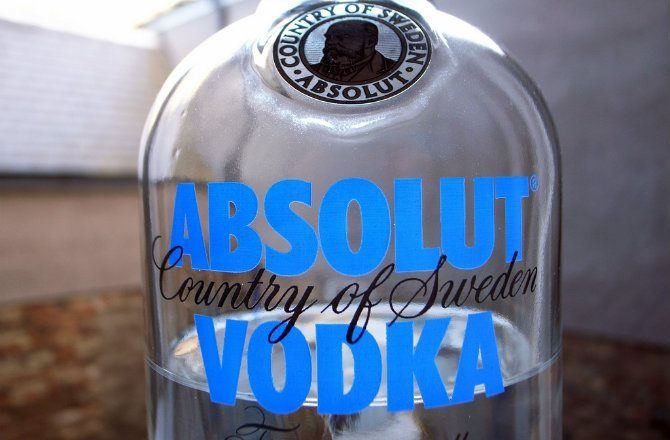Spirits 101: Vodka
We at TheSpir.it want nothing more than to educate our readers about any and all spirits and cocktails that come our way. In order to show our appreciation for your need for a spirit-ual education, we welcome you to our several-month series dedicated to any and all spirits. Maybe you've heard of them, maybe you haven't, but either way, you may learn something you never knew about your favorite spirit before! Consider this the beginning of some much needed spirit-ual guidance. Cheers!
Vodka is the most popular distilled spirit category in the U.S., one with a centuries-old history behind it primarily from Eastern Europe and Russia. The term vodka is, in fact, derived from the Slavic word voda, which means "little water." The reference to water makes some sense since the U.S. government defines vodka as a spirit with no distinctive character, aroma, taste, or color, even though most spirits experts disagree with that definition.
Essentially, vodka is an un-aged, neutral spirit that is distilled from any fermentable matter, including vegetables (such as onions, sugar beets) and grains. The potato is used for the production of vodkas in Poland, Scandinavia, and North America, but grains such as rye, wheat, barley, and corn are the more popular choices with distillers.
Potable liquids were distilled on a small scale in Eastern Europe as early as the 13th century CE. But large-scale vodka production began in western Russia in the 15th century. Until the late 19th century, all the world's vodkas were produced in the original method of distillation, the pot-still method.
First, grains were heated in water to release the starches for conversion into sugar. The soupy liquid was called a "mash." Then the mash had yeast added to it to spur fermentation before distilling, essentially creating a beer. Originally, vodka was the product of a single distillation with a relatively low proof. By the 16th century, distillers learned the benefits of two or more distillations in order to improve product quality and the raise the alcohol level. A second distillation heightened both the strength and the purity of the final product.
Most contemporary vodka has no color, but the majority of domestic and imported vodkas do have distinctive aromas, textures, and flavors, which are dictated by the base materials, the type of distillation and the variety of filtration. For centuries, vodka has been flavored with herbs, spices, honey, and fruit. Nowadays it is commonplace for vodka brands to have flavored line extensions, using a whole universe of flavorings from fruits and spices to herbs and vegetables.
Source: Encyclopedia Britannica
Below are tasting notes of some vodkas that I had the pleasure of tasting. Some are flavored, some are not, but all are worth trying!
Naked Jay Vodka: Creamy on the nose, hints of vanilla and cinnamon spice. Very harsh and acidic on the palate, a very heavy burn for vodka. Creamy mouthfeel, but not sure if I would drink this without a dominating mixer.
Naked Jay Big Dill: The neon green color is a little intimidating, but the briny, sour smell of pickles is surprisingly tame. The smell of pickles is definitely there, but the taste is not. This is a decent vodka with a hint of pickle, but there isn't enough of a defined pickle flavor.
Naked Jay Whipped Cream: Sweet and creamy on the nose, this definitely smells of a very rich whipped cream. Unlike the Big Dill flavored vodka from Naked Jay, the whipped cream actually does have a satisfying whipped cream flavor, without it tasting like a sugar bomb. Tastes like sweet cream ice cream.
Platinum 7X: Caramel and vanilla on the nose. Hints of clove and cinnamon even, like a pumpkin-spiced coffee drink. Very smooth and creamy, wheaty. Wet cereal and raw oats are very present. No acidity, a very pleasant vodka to sip on.
Ketel One Vodka: Clean and crisp on the nose, notes of fresh apples and pears. A hint of spice on the back of the tongue, with a nice amount of acidity at the back of the throat. Creamy mouthfeel, with notes of apricot and peach. A very smooth finish, this is a rich vodka with a lot of body and character.
Ketel One Oranje: This smells like fresh tangerines and clementines; sweet and citrusy with a hint of tang on the nose. The orange fruit flavor is manageable and pleasant without being too much. There is also a hint of spice which is very refreshing, like drinking an iced orange tea. Very smooth and satisfying.
Ketel One Citroen: The lemon flavor is very present on the nose without channeling too much lemon cleaning product, which most citron vodkas tend to do. Hints of lime are also present, providing a nice sour contrast to the sweet and tangy lemon. The lemon flavor tastes fresh and is more of a suggestion than an in-your-face flavor. Would be nice over ice with lime zest.
SKYY Coconut Vodka: I find most coconut flavored vodkas to smell like suntan lotion rather than actual coconut. This, however, tastes like there is shaved coconut in the glass! Very clean and refreshing. Crisp, smooth, but a slight chemical-like burn at the end. A nice coconut vodka indeed.
SKYY Pineapple Vodka: An incredibly unexpected fresh and sweet smell of pineapples on the nose, I feel like I could take a bite out of a juicy piece of it! Sweet and crisp on the palate without tasting like fake pineapple flavoring. This is absolutely one of the better flavored vodkas I've had.
SKYY Ginger Vodka: This has a very interesting ginger flavor to it; it has a lot more spice to it. Very crisp and clean. A slight fruity aspect to it, stone fruits and red berries. Has the flavor of a fresh piece of ginger, rather than ginger ale. This would be great for a twist on a Moscow Mule with an extra hit of ginger flavor.
— Sara Kay, The Spir.it
